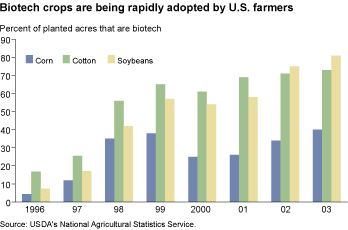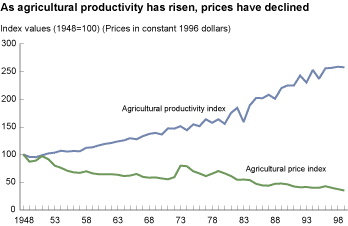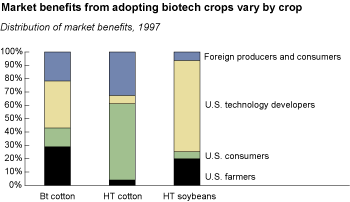Consumers and the Future of Biotech Foods in the United States
- by Robbin Shoemaker, Demcey Johnson and Elise Golan
- 11/1/2003
Biotechnology is often associated with promise…promise to feed the world, promise to reduce environmental harm, promise to expand agricultural markets and production possibilities, promise to create products that consumers want.
Farmers in the United States seem to be sold on these promises. Although first generation biotech crops have been in commercial use for only 8 years, farmers have rapidly adopted them because of their ability to survive herbicides and/or pests. In 1996, fewer than 5 percent of U.S. soybean acres were planted to herbicide-tolerant (HT) seeds; in 2002, 75 percent of soybean acres were planted to HT soybeans—a 1,400-percent increase in just 6 years. Adoption rates of biotech commodities that are used for nonfood purposes—animal feed and textiles, for example—have also increased rapidly.
Seed development, chemical, and pharmaceutical firms seem to be sold, too. Anticipating significant returns from both agricultural and pharmaceutical biotechnology, these firms acquired small biotech start-up firms (and their biotech patents) in the 1990s and transformed themselves into large “life science” companies. While some pharmaceutical firms have since divested their agricultural holdings after failing to realize adequate returns on their investments, large agricultural biotechnology companies—like Monsanto—have maintained agbiotech research and development programs, partly because of expected greater returns on second- and third-generation biotechnology.
But, are American consumers sold? Unlike their European counterparts, American consumers have, so far, not been vocal about their opinions on biotech food, though they have been eating them. Biotech grains, in the form of cornmeal, oils, and sugars, are used as ingredients in many foods that Americans consume, such as corn chips. Because these foods are deemed substantially equivalent to their nonbiotech counterparts, they are not labeled as “biotech.” As such, consumers are largely unaware they are eating products derived from biotechnology. But that may change when the new generation of products in the pipeline actually hits grocery stores. These new products may be substantially different from their nonbiotech counterparts or, in some cases, completely new. When consumers are made aware that these products are biotech, how will they react? As the largest market for U.S. producers, American consumers will render the ultimate verdict on the future of agricultural biotechnology in the United States
Biotech Products Reap Multiple Benefits
Much of what we know about agricultural biotechnology stems from our experience with the first generation of biotech products, mainly crops with enhanced agronomic traits, such as pest resistance or herbicide tolerance. These products help farmers by reducing production costs or increasing yields.
Only about a third of the first-generation biotech products are in commercial use; many more are expected to come through the pipeline in the next few years (see box “What’s in the Pipeline?”). The second generation of biotech products, currently being developed, are mostly food products that offer benefits beyond the farm gate, such as enhanced nutritional value. Golden rice, for example, contains beta-carotene, a source of vitamin A. The products of the third generation will also offer benefits to consumers and others through a wide range of nonfood uses—from edible vaccines to environmental cleanup to reducing the spread of malaria from mosquitoes.
Most farmers using first-generation products have generally benefited from modest increases in yields and net returns from reduced use of insecticides and herbicides. Users of HT crops have seen increased yields and returns, but users of bacillus thuringiensis crops (Bt crops, which are toxic to certain pests) have had more mixed results. The financial benefits of Bt crops depend on the presence or persistence of pests. Farmers also realize nonfinancial benefits in the form of convenience and reduced management time. Many farmers who work off the farm rely on Bt crops to make more time available for off-farm work.
And U.S. farmers aren’t the only ones who benefit. Based on an analysis of three biotech crops (Bt cotton, HT cotton, and HT soybeans), the financial benefits to U.S. farmers accounted for no more than a third of the estimated total benefits associated with biotech crops in 1997. And, the distribution of benefits varies by crop. Larger shares of the benefits went to the biotechnology developers in the form of technology fees or to domestic and foreign consumers through lower commodity prices. Although the results depend on a number of factors, including the estimated cost savings associated with biotech adoption and the sensitivity of supply and demand for each commodity to price changes, they do suggest that consumers capture many of the financial benefits associated with more efficient production. When we consider benefits to consumers in terms of stable or declining food prices, we see that agricultural biotechnology is part of a long line of agricultural technologies that continue the secular trend of ever-increasing agricultural productivity and declining real agricultural commodity prices.
That Leads Us to the Consumers
U.S. consumers are a varied group and their reactions to new biotech foods are likely to be varied as well. Their reactions to products reflect their demographic characteristics, needs, and preferences. Income, price, education, age, family size, time constraints, diet-health information, and ethnic background all affect the amount and type of food that families buy and consume. In recent years, changes in household composition and growth in ethnic diversity and incomes have driven demand for greater variety, convenience, and quality.
By and large, the U.S. food marketing system is responding to these demands. The total number of food products available in today’s marketplace now exceeds 300,000 (although not all at once and not in every store), and the number of new food product introductions averaged over 10,000 items per year throughout the 1990s. These new food products—ranging from calcium-enriched orange juice to yogurt pops to shade-grown coffee—have many attributes, including more convenience, ethnic variety, enhanced nutritional value, and environmental benefits.
Second-generation biotech foods also promise variety and quality, making them well-targeted to recent trends in consumer demand. Whether these foods can successfully compete with other foods on grocery store shelves depends on consumer attitudes toward agricultural biotechnology.
What Influences Consumer Attitudes?
Results of public opinion polls convey mixed messages about U.S. consumer attitudes toward biotechnology. Over the past 2 years, polls by ABC News have shown strong support for mandatory labeling of bioengineered food, even while concerns about the safety of these foods have abated. Other surveys have revealed that consumers do not know much about bioengineered foods, and most do not have firmly held beliefs about these products. Commenting on results of a 2001 consumer survey, Mike Rodemeyer of the Pew Initiative on Food and Biotechnology argued that “Essentially, public opinion is ‘up for grabs’ because this new technology has moved faster than the public’s ability to fully understand it and its implications.”
Consumer attitudes are also influenced by the regulatory environment, which includes labeling policies. In the United States, biotech foods that are substantially equivalent to their conventional counterparts in terms of composition, nutritional attributes, allergens, and other characteristics do not need to be labeled as “biotech.” So far, none of the biotech foods in the U.S. market has required labeling.
In other parts of the world—including the European Union and Japan—labeling of foods with biotech content is mandatory, even without scientific evidence of specific health risks to consumers. Mandatory labeling policies in foreign markets, while intended to satisfy consumers’ “right to know,” may tend to accentuate concerns about product safety (see “Mandatory Labeling Versus Voluntary Labeling”). U.S. policies, in contrast, have helped to foster the passive acceptance of biotech products (for example, soybean oil derived from biotech soybeans) by domestic consumers and food manufacturers.
Consumer attitudes are affected by the type and source of information about agricultural biotechnology. In a recent study, ERS and university researchers conducted experimental auctions to assess consumer attitudes toward biotech foods, the effect of labels, and the role of different kinds of information. In 12 separate auctions, involving 172 consumers in two Midwestern cities, participants were given the opportunity to bid for and purchase three different food products—vegetable oil, tortilla chips, and potatoes—with and without biotech labels. Before the bidding, they were given information packets containing statements about biotechnology from a variety of sources. Pro-biotech statements were provided by a group of leading biotech companies. Greenpeace provided anti-biotech statements. Science-based verifiable statements were provided by a group of individuals knowledgeable about biotechnology, none of whom had a financial stake in agricultural biotechnology. The source of each statement was identified.
Participants’ bids, or the amount they were willing to pay, for biotech-labeled and plain-labeled foods were affected by the information packets they received. Participants who received only pro-biotech information bid slightly more on the biotech-labeled food for two of the three products. Participants who received only anti-biotech information bid 35 percent less, on average, on the biotech-labeled food than on the plain-labeled food. Those who received both pro- and anti-biotech information bid 16-29 percent less, on average, on the biotech-labeled foods than on the plain-labeled food, depending on the food product. These results are consistent with other studies that show that individuals place a greater weight on negative information than on positive information. However, when participants received science-based verifiable information, in addition to both pro- and anti-biotech information, the average price discount—the difference between their bids on biotech-labeled foods and on plain-labeled foods—dropped to between 0 and 11 percent. This confirms the powerful role of credible, scientific information in shaping consumer attitudes. Consumers react not just to the content of information about biotechnology, but also to the source.
Will U.S. Consumers Accept New Biotech Foods?
It’s hard to say. We know consumers want and expect variety. Agricultural biotechnology can be a tremendous source of variety—both in terms of choices of production techniques for farmers in developed and developing countries and in terms of new and different products for consumers. Further, biotechnology may provide food quality enhancements not previously available (nonallergenistic peanuts or other foods, for example) that consumers may greatly desire.
We also know that consumers are influenced by various types and sources of information and make choices based on the information they receive, as well as on their own needs and preferences. Consumers who are anxious about biotechnology but who also want previously unavailable food characteristics will face new tradeoffs among food choices.
What is the net effect? How will new biotechnology-derived food be judged in the future? The jury is still out.
This article is drawn from:
- Golan, E., Kuchler, F., Mitchell, L., Greene, C. & Jessup, A. (2001). Economics of Food Labeling. U.S. Department of Agriculture, Economic Research Service. AER-793.
- Tegene, A., Huffman, W., Rousu, M. & Shogren, J.F. (2003). The Effects of Information on Consumer Demand for Biotech Foods: Evidence from Experimental Auctions. U.S. Department of Agriculture, Economic Research Service. TB-1903.
- Fernandez-Cornejo, J. & McBride, W.D. (2002). Adoption of Bioengineered Crops. U.S. Department of Agriculture, Economic Research Service. AER-810.
- Price, G., Lin, W., Falck-Zepeda, J. & Fernandez-Cornejo, J. (2003). Size and Distribution of Market Benefits From Adopting Biotech Crops. U.S. Department of Agriculture, Economic Research Service. TB-1906.
- The Effects of Information on Consumer Demand for Biotech Foods: Evidence from Experimental Auctions. (2003). USDA, Economic Research Service. TB-1903..




